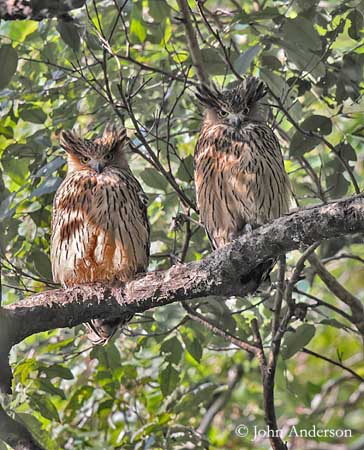
Fr: Kétoupa roux
All : Himalayafischuhu
Esp: Búho Pescador Leonado
Ital: Gufo fulvo pescatore
Nd: Himalayavisuil
Sd: Gulfotad fiskuv
Photographer:
John Anderson
John Anderson Photo Galleries
Text by Nicole Bouglouan
Sources:
HANDBOOK OF THE BIRDS OF THE WORLD Vol 5 by Josep del Hoyo-Andrew Elliott-Jordi Sargatal - Lynx Edicions - ISBN: 8487334253
HANDBOOK OF THE BIRDS OF INDIA AND PAKISTAN – vol 3 – By Salim Ali and Dillon Ripley – OXFORD UNIVERSITY PRESS – ISBN: 195613023
OWLS OF THE WORLD – By Claus König, Friedhelm Weick and Jan-Hendrik Becking - IBSN 978-0-7136-6548-2
A photographic guide to Birds of Vietnam, Cambodia and Laos by Peter Davidson. New Holland Publishers. ISBN: 9781847731418
A Field Guide to the Birds of South-East Asia by Craig Robson. New Holland Publishers. ISBN: 9781780090498
BirdLife International (BirdLife International)
Article: Fish-owls
Tawny Fish-Owl
Ketupa flavipes
Strigiforme Order – Strigidae Family
BIOMETRICS:
Length: 48-55 cm
DESCRIPTION:
Like other owls of genus Ketupa, the Tawny Fish-Owl is nocturnal. However, this large owl can be conspicuous by day too, leaving its day-roost for perching in tree above water and searching for prey.
The adult has orange-rufous facial disk with indistinct dark brown border. Loral area and eyebrows are white.
The upperparts are rich orange-rufous with broad, blackish-brown streaks. Flight feathers are barred dark brown. The dark brown tail is barred pale buff.
On the underparts, the throat is white and often well defined. Rest of underparts is orange-rufous with blackish-brown shaft streaks, often broader on the breast.
The bill is horn-blackish, sometimes paler at tip. The eyes are yellow. On the legs, tarsi are only partially feathered. The yellowish-green to slaty-green feet show spiny scales on the soles, easier for holding the fish.
Both sexes are similar.
The juvenile has spotted upperparts whereas underparts show darker streaks.

VOICE: SOUNDS BY XENO-CANTO
The Tawny Fish-Owl at roost sometimes gives slightly hissing “fshhht” and also high, weak, falling “pheeeeooo, piii’iooo”.
Male’s song is a quick, deep, muffled “huh-huh WOOo” with last note rising quickly and then falling. The female responds by uttering a cat-like mewing “hew”. The territorial call is a deep “whoo-hoo”.
HABITAT:
The Tawny Fish-Owl frequents evergreen-forested streams or rivers at lower elevations, and freshwater swamp forest, but it usually prefers running water.
This species is visible from lowlands up to 1500 metres of elevation or more according to the range.
RANGE:
The Tawny Fish-Owl is resident in N and NE Indian Subcontinent, C and S China and Taiwan. In SE Asia, this species is rare or local resident in NE Myanmar, N and C Laos, W Tonkin and Cochinchina.

BEHAVIOUR:
The Tawny Fish-Owl feeds primarily on fish, but it also takes crayfish, shrimps, crabs, amphibians, lizards, snakes, large insects and small mammals, often rodents. It may kill large birds such as partridges, pheasants and junglefowls.
This species hunts mainly at dusk and by night, but it can be active by day too, especially when feeding chicks. Like numerous owls, it hunts from perch and swoops down onto the prey or catches the fish near water surface in fish-eagle manner.
It often perches on tall trees, watching for preys in the water below. It usually hunts along streams where it can find its favourite preys.
This bird has specialized toes with spiny scales on the soles, and partially feathered tarsi too, making easier to hold the fish.
The behaviour of this owl during the breeding season is little known. However, during courtship, both mates may be heard duetting. Courtship feeding from male to female probably occurs like in numerous Strigidae.
This species is resident in its range.
FLIGHT:
The Tawny Fish-Owl has fairly silent flight like all Strigidae species, due to peculiar physical features of feathers. But the owls of genus Ketupa lack the comb-like fringes on primary feathers, making their flight not as quiet as that of other owls.
REPRODUCTION:
The breeding season occurs between December and February in India, with the laying between November and February in western parts of the range.
The Tawny Fish-Owl often uses an abandoned large raptor or fish-eagle nest in tall tree near water. It may also nest in hollow in ravine or river bank. There is no lining and the eggs are laid on bare earth.
The female lays one or two white eggs. Both adults share the incubation, but the period is unknown.
Nest defence is often by female which can be very bold and aggressive against intruders or predators.

DIET:
The Tawny Fish-Owl feeds mainly on aquatic preys such as fish, shrimps, crabs and amphibians, but it also takes lizards and snakes, small rodents, large insects, and even large birds such as pheasants.
It hunts from perch from which it swoops down onto the prey or catches fish near water surface.
PROTECTION / THREATS / STATUS:
The Tawny Fish-Owl is local to uncommon according to the range. The species is threatened by destruction of the habitat, especially forests, and it is vulnerable to persecution.
However, the species is not currently threatened.